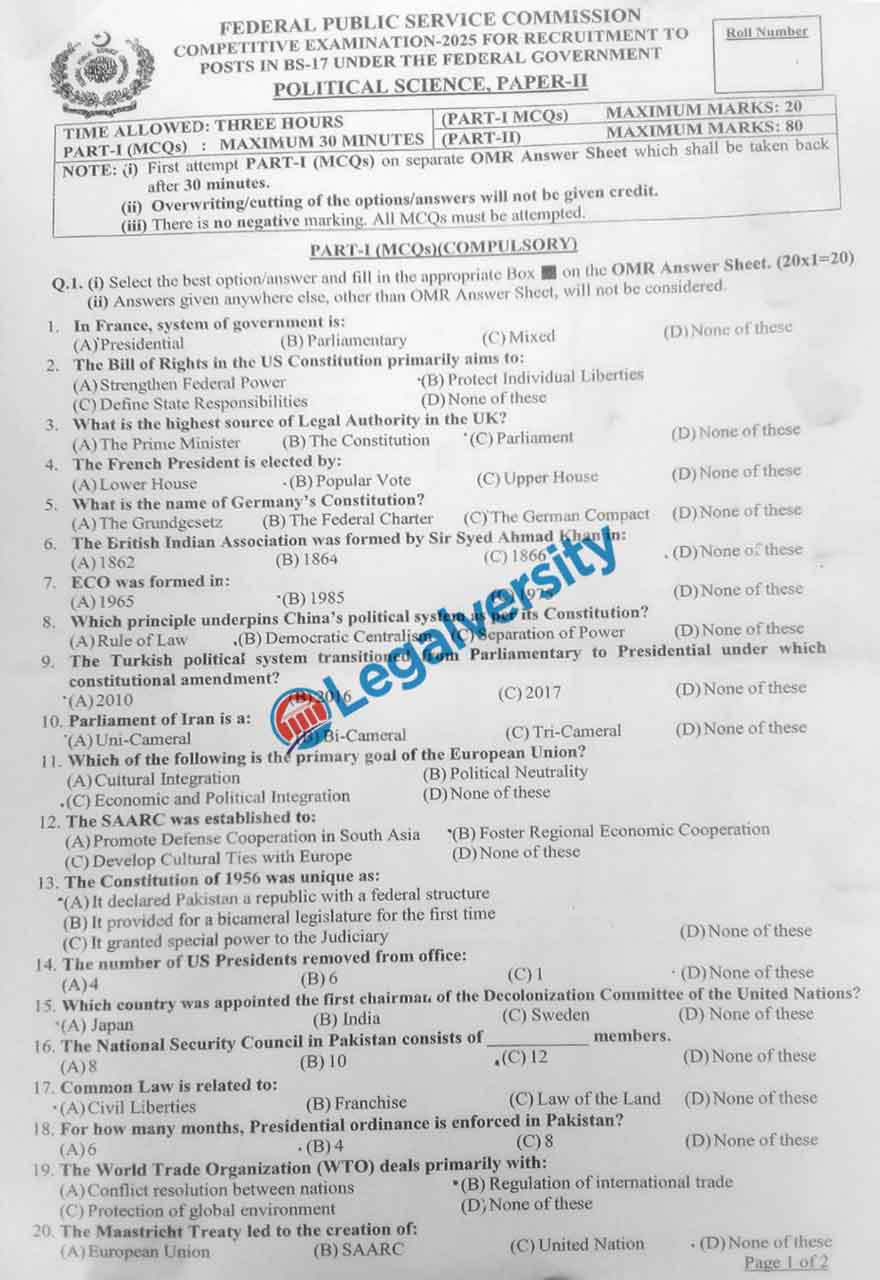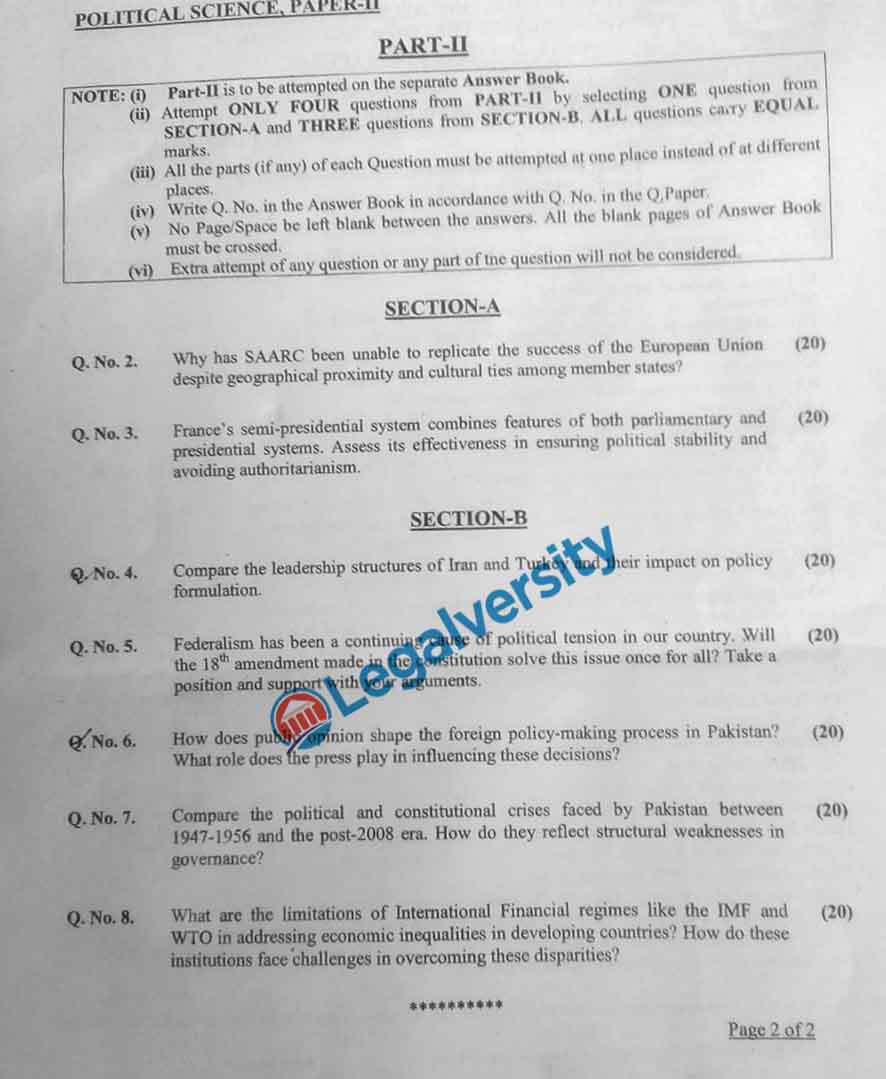Political Science is an optional subject in the CSS competitive examination 2025. Here, you will find the CSS Political Science past Paper-II 2025. I will also provide a summary of the paper, in which you will analyze what topics were given and how difficult they were. This lets you better understand the paper and prepare well for future examinations.
CSS Political Science Past Paper-II 2025
SECTION-A
Q1. Why has SAARC been unable to replicate the success of the European Union despite geographical proximity and cultural ties among member states?
Q2. France’s semi-presidential system combines features of both parliamentary and presidential systems. Assess its effectiveness in ensuring political stability and avoiding authoritarianism.
SECTION-B
Q3. Compare the leadership structures of Iran and Turkey and their impact on policy formulation.
Q4. Federalism has been a continuing cause of political tension in our country. Will the 18th Amendment made in the Constitution solve this issue once and for all? Take a position and support with your arguments.
Q5. How does public opinion shape the foreign policy-making process in Pakistan? What role does the press play in influencing these decisions?
Q6. Compare the political and constitutional crises faced by Pakistan between 1947 and 1956 and the post-2008 era. How do they reflect structural weaknesses in governance?
Q7. What are the limitations of International Financial regimes like IMF and WTO in addressing economic inequalities in developing countries? How do these institutions face challenges in overcoming these disparities?
Critical Analysis of the Paper
SAARC has struggled to achieve the success of the European Union due to deep-rooted political tensions, lack of economic integration, and weak institutional frameworks. Unlike the EU, which emerged from a strong commitment to economic interdependence and political cooperation, SAARC members remain divided by historical conflicts, particularly between India and Pakistan. Additionally, weak intraregional trade, differing economic priorities, and a lack of binding commitments have hindered SAARC’s effectiveness in fostering regional integration.
France’s semi-presidential regime combines parliamentary and presidential forms, a balance of executive power with legislative control. Though the directly elected president provides stability, the position of prime minister avoids tyranny. The regime has prevented France from becoming authoritarian by keeping institutions in check and being capable of change. Cohabitation, where the president and premier are from different parties, may create policy gridlock, lowering the efficiency of government.
Iran’s leadership structure, dominated by the Supreme Leader, centralizes authority in religious institutions, limiting democratic participation. Policy formulation is heavily influenced by the clerical elite, with limited checks on executive power. In contrast, Turkey’s leadership structure, especially after recent constitutional reforms, has shifted towards a strong presidential system, consolidating power under the president.
This has resulted in a more centralized decision-making system, although Turkey still has electoral competition and a relatively autonomous bureaucracy in comparison to Iran. Federalism within Pakistan has long been a source of political tension, with the provinces calling for more autonomy.
The 18th Amendment aimed to resolve these tensions by transferring power to the provinces. The implementation remains weak, and fiscal disputes persist with the question of governance capacity at the provincial level. The amendment resolves only part of the stresses on the federation, not addressing the underlying structures driving regional grievances.
Public opinion significantly shapes Pakistan’s foreign policy, particularly on issues like relations with India, the U.S., and the Muslim world. Popular sentiment, influenced by historical narratives and national identity, often pressures policymakers to adopt hardline stances. The press plays a critical role in shaping public opinion, framing diplomatic issues, and amplifying nationalist rhetoric.
However, media biases and state control over information can sometimes distort public perception, limiting informed debate on foreign policy matters. Between 1947 and 1956, Pakistan faced constitutional crises due to a lack of democratic traditions, frequent leadership changes, and difficulties in drafting a constitution. The post-2008 era has seen crises related to judicial independence, civil-military relations, and governance challenges. Both periods highlight structural weaknesses in Pakistan’s political system, particularly the absence of institutional stability, weak rule of law, and executive dominance over democratic processes.
International financial institutions like the IMF and WTO often struggle to address economic inequalities in developing countries. The IMF’s structural adjustment programs impose austerity measures that can deepen economic hardship, while the WTO’s trade policies frequently favor developed nations. These institutions face challenges in overcoming disparities due to political influence from powerful economies, rigid economic frameworks, and the lack of tailored solutions for developing nations’ diverse economic conditions.
View the CSS Political Science Past Paper-II 2025


Also read:
